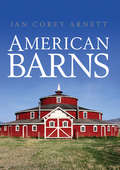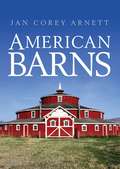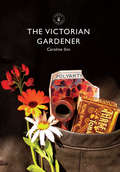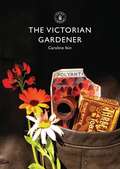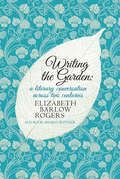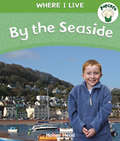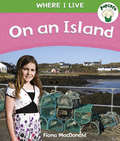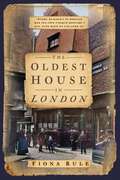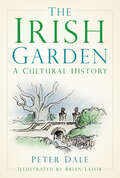- Table View
- List View
American Barns (Shire Library Usa Ser. #751)
by Jan Corey ArnettThe heart of every working farm and ranch, the barn is an icon of rural America. This book chronicles – and celebrates – all the main types, and looks at how these treasures of early American architecture developed. It explains how a wealth of immigrant construction methods and range of environments and climates resulted in a fascinating variety of barn styles in the United States, from the earliest rare Dutch examples to simpler English types and others in more surprising shapes (round or even polygonal) crafted by the Shakers in the 1800s. It highlights the most notable, famous and historic barns that the reader can visit, and features the efforts of conservation groups to preserve America's barns and find innovative ways to repurpose these glorious old structures as homes and studios – and as living monuments of rural heritage.
American Barns (Shire Library USA #751)
by Jan Corey ArnettThe heart of every working farm and ranch, the barn is an icon of rural America. This book chronicles – and celebrates – all the main types, and looks at how these treasures of early American architecture developed. It explains how a wealth of immigrant construction methods and range of environments and climates resulted in a fascinating variety of barn styles in the United States, from the earliest rare Dutch examples to simpler English types and others in more surprising shapes (round or even polygonal) crafted by the Shakers in the 1800s. It highlights the most notable, famous and historic barns that the reader can visit, and features the efforts of conservation groups to preserve America's barns and find innovative ways to repurpose these glorious old structures as homes and studios – and as living monuments of rural heritage.
The Victorian Gardener (Shire Library #780)
by Caroline IkinOver the course of the nineteenth century, gardening came to be considered a respectable profession, providing a means to an education, a good chance of advancement and decent working conditions. The hierarchy of the garden staff became just as regimented as that of domestic servants, and progression was attained by hard work, self-improvement and ambition. Training courses and apprenticeships prepared young gardeners for their trade and horticulture became recognised as a skilled profession, with the head gardener commanding a position of influence and respect and women overcoming social barriers to join their peers on equal terms. This book explores the gardening profession within the complexities of Victorian society and the advances in science and technology that pushed the gardener further into the limelight.
The Victorian Gardener (Shire Library)
by Caroline IkinOver the course of the nineteenth century, gardening came to be considered a respectable profession, providing a means to an education, a good chance of advancement and decent working conditions. The hierarchy of the garden staff became just as regimented as that of domestic servants, and progression was attained by hard work, self-improvement and ambition. Training courses and apprenticeships prepared young gardeners for their trade and horticulture became recognised as a skilled profession, with the head gardener commanding a position of influence and respect and women overcoming social barriers to join their peers on equal terms. This book explores the gardening profession within the complexities of Victorian society and the advances in science and technology that pushed the gardener further into the limelight.
London’s Royal Parks (Shire Library #793)
by Paul RabbittsLondon's royal parks are amongst its most beautiful and beloved spaces: just as much as the Houses of Parliament, Buckingham Palace and Victoria Station, the mere mention of Hyde or Regent's Park is enough to evoke the capital in all its glory for residents and tourists alike. They have a grand history – some having been royally-owned as far back as the Norman conquest, and others having been acquired by Henry VIII during the Reformation – and since being opened to the public during the eighteenth century have hosted some of London's great events, including the Great Exhibition and innumerable jubilees and celebrations. This book tells the story of all nine of the parks from the point when they were acquired by the monarchy until the present day, including the major historic moments and events with which they are associated.
London’s Royal Parks (Shire Library)
by Paul RabbittsLondon's royal parks are amongst its most beautiful and beloved spaces: just as much as the Houses of Parliament, Buckingham Palace and Victoria Station, the mere mention of Hyde or Regent's Park is enough to evoke the capital in all its glory for residents and tourists alike. They have a grand history – some having been royally-owned as far back as the Norman conquest, and others having been acquired by Henry VIII during the Reformation – and since being opened to the public during the eighteenth century have hosted some of London's great events, including the Great Exhibition and innumerable jubilees and celebrations. This book tells the story of all nine of the parks from the point when they were acquired by the monarchy until the present day, including the major historic moments and events with which they are associated.
Icehouses (Shire Library)
by Tim BuxbaumOften hidden away or incorporated into other architectural features, icehouses are a largely forgotten part of our heritage. As winters warmed through the nineteenth century, and supplies of natural ice declined, the development of artificial refrigeration made redundant these curious buildings – often status symbols in themselves – which had been designed to store winter snow and ice into the summer. Icehouses allowed perishables to be preserved, chilled delicacies to be enjoyed, and fevers to be relieved – and on a commercial scale they fed an international trade that carried snow from mountain peaks and ice from frozen lakes to supply the needs of industry, markets and householders. In this illustrated introduction, Tim Buxbaum explains how icehouses developed; how, when and where they were built; and how they operated, including a chapter on icehouses from around the world.
Icehouses (Shire Library)
by Tim BuxbaumOften hidden away or incorporated into other architectural features, icehouses are a largely forgotten part of our heritage. As winters warmed through the nineteenth century, and supplies of natural ice declined, the development of artificial refrigeration made redundant these curious buildings – often status symbols in themselves – which had been designed to store winter snow and ice into the summer. Icehouses allowed perishables to be preserved, chilled delicacies to be enjoyed, and fevers to be relieved – and on a commercial scale they fed an international trade that carried snow from mountain peaks and ice from frozen lakes to supply the needs of industry, markets and householders. In this illustrated introduction, Tim Buxbaum explains how icehouses developed; how, when and where they were built; and how they operated, including a chapter on icehouses from around the world.
The Edwardian Gardener’s Guide: For All Garden Lovers (Old House Ser.)
by Twigs WayIt is Edwardian England, and a delightful flower garden and fruitful allotment are matters of personal pride, boons for the family dinner table, and even 'important acts of local patriotism'. 'The Edwardian Gardener's Guide' selects nuggets of wisdom from the best-selling 'One & All' garden books, originally published in 1913. In these short booklets, the foremost agricultural and horticultural writers of the period revealed fashions in gardening styles, the best seasonal plants, how to enhance food production and how best to lay out adventurous rockeries, ferneries and grottoes. Packed with charming contemporary advertisements and colour illustrations, this handbook gives a glimpse of the pre-First World War 'golden era' of British gardening. With an introduction by garden historian Twigs Way.
The Edwardian Gardener’s Guide: For All Garden Lovers (Old House Ser.)
by Twigs WayIt is Edwardian England, and a delightful flower garden and fruitful allotment are matters of personal pride, boons for the family dinner table, and even 'important acts of local patriotism'. 'The Edwardian Gardener's Guide' selects nuggets of wisdom from the best-selling 'One & All' garden books, originally published in 1913. In these short booklets, the foremost agricultural and horticultural writers of the period revealed fashions in gardening styles, the best seasonal plants, how to enhance food production and how best to lay out adventurous rockeries, ferneries and grottoes. Packed with charming contemporary advertisements and colour illustrations, this handbook gives a glimpse of the pre-First World War 'golden era' of British gardening. With an introduction by garden historian Twigs Way.
Humphry Repton (Shire Library)
by Laura MayerHumphry Repton (1752–1818) ambitiously styled himself Capability Brown's successor: the century's next great improver of landed property. With his rare combinations of skills – he was a talented topographical sketcher with an excellent knowledge of farming – over thirty years Repton amassed an incredible four hundred commissions, ingratiating himself with the aristocracy and raising the status of his adopted profession. His famous Red Books, illustrated to help clients visualize the potential of their estates, also did their part to encourage the appreciation of landscape aesthetics. With colourful illustrations and detailed site investigations, this book traces Repton's landscape designs from Picturesque wildernesses like Blaise Castle to the progressive Gardenesque style of Wanstead House in Greater London. It is both a perfect visitor's guide to the gardens and an introduction to the theory of Repton's work.
Humphry Repton (Shire Library)
by Laura MayerHumphry Repton (1752–1818) ambitiously styled himself Capability Brown's successor: the century's next great improver of landed property. With his rare combinations of skills – he was a talented topographical sketcher with an excellent knowledge of farming – over thirty years Repton amassed an incredible four hundred commissions, ingratiating himself with the aristocracy and raising the status of his adopted profession. His famous Red Books, illustrated to help clients visualize the potential of their estates, also did their part to encourage the appreciation of landscape aesthetics. With colourful illustrations and detailed site investigations, this book traces Repton's landscape designs from Picturesque wildernesses like Blaise Castle to the progressive Gardenesque style of Wanstead House in Greater London. It is both a perfect visitor's guide to the gardens and an introduction to the theory of Repton's work.
Gardening Women: Their Stories From 1600 to the Present
by Dr Catherine HorwoodFrom Flora, Roman goddess of plants, to today's gardeners at Kew, women have always gardened. Women gardeners have grown vegetables for their kitchens and herbs for their medicine cupboards. They have been footnotes in the horticultural annals for specimens collected abroad. They taught young women about gardening twenty-five years before women's horticultural schools officially existed. And their influence on the style of our gardens, frequently unacknowledged, survives to the present day.From these triumphs to the battles fought against male-dominated institutions, from the horticultural pioneers to the bringers of change in society's attitudes, this book is a celebration of the best of the species -- gardening women.
Granny's Household Hints: Traditional Tips for a Clean, Green Home
by Brenda EvansIn Granny's day there were few labour-saving devices or fancy cleaning products. So when it comes to getting stains out of the carpet or keeping her laundry sparkling white, she still prefers tried-and-tested techniques handed down through the generations. Many people nowadays would prefer to use natural, traditional cleaning methods, rather than chemicals that can be harmful to our health and the environment. So why not follow in Granny's footsteps and try her effective, green and surprisingly simple household hints? Learn how to keep your home spotless using common ingredients found in your kitchen cupboard, like lemon juice or bicarbonate of soda. You'll be helping the planet and your wallet too ... Granny would be proud!
AQA Design & Technology: Product Design (3-D Design) AS/A2 (PDF)
by Will Potts Brian EvansSpecifically written to cover AQA's Product Design (3-D Design) specification, our student book takes a focused look at design and manufacturing processes, providing a visual insight into specific products and industries to help motivate students. Clear learning objectives at the start of each chapter, helping students focus on what they need to know. Key terms reinforce learning, providing definitions of key words that students need to be familiar with. Includes a range of activities that encourages your students to analyse materials and manufacturing processes used in product design.
Writing the Garden: A Literary Conversation Across Two Centuries
by Elizabeth Barlow RogersThis is a fascinating exploration of the writings and personalities who have shaped our ideas about gardens and gardening. Gardening, more than most outdoor activities, has always attracted a cult of devotedly literate practitioners - people who like to dig, it appears, also like to write. And many of them write exceedingly well. Focusing on gardeners' words about the art of gardening, "Writing the Garden" brings together a diverse array of authors. For the most part they are not professional landscape designers or how-to horticulturalists, but rather hands-on gardeners who write with their own gardens in full-view. Ranging in time and place from Enlightenment France to modern-day New York City, they invite the reader into the natural world of soil and flowers. Authors discussed include Jean-Jacques Rousseau, Thomas Jefferson, Henry David Thoreau, Gertrude Jekyll, Vita Sackville-West, Russell Page, Lynden Miller, and many more.
By the Seaside: By The Seaside Library Ebook (Popcorn: Where I Live)
by Honor HeadA colourful introduction for young readers to the seaside. The young boy, Alex, tells us all about his home town at the seaside and the things in his local area such as his school, what he does after school, going to the seafront and the beach, what he does at the weekend, the different jobs people do there, different sorts of shops that are at in seaside towns and how people get about.Includes a picture quiz and free downloadable worksheets.This book encourages children to think about the similarities and differences between the place where they live and where other people live.
In a City: In A City Library Ebook (Popcorn: Where I Live)
by Honor HeadLooks at the different localities that people live in.
In a Village: In A Village Library Ebook (Popcorn: Where I Live)
by Honor HeadA colourful introduction for young readers to life in a village. The young girl, Kira, tells us all about her home in a village and the things in her local area such as her school, what she does after school, village churches, fun at the weekend, farms, shopping, jobs and transport.Includes a picture quiz and free downloadable worksheets.This book encourages children to think about the similarities and differences between the place where they live and where other people live.
On an Island (Popcorn: Where I Live)
by Fiona MacdonaldFind out what it's like to live on the Isle of Coll, also recognised as the Isle of Struay in Katie Morag's books. Meet Lexi to find out what school is like on the island, see how people travel around what jobs people do there, what people do in their leisure time, what wildlife there is on island and how people shop.
Homes: Homes Library Ebook (Your Local Area #1)
by Ruth ThomsonThese books will help you think about and look around your local area. Find out what your surroundings can tell you about how people live and work, where they shop and go to school and how they travel and spend their leisure time. Discover the clues that will tell you how people lived in the past. Think about the changes that could benefit your local area, whether it's your home, school or further afield.
The Oldest House in London: London Through The Eyes Of Its Oldest House
by Fiona RuleLondon's old buildings hold a wealth of clues to the city’s rich and vibrant past. The histories of some, such as the Tower of London and Westminster Abbey, are well documented. However, these magnificent, world-renowned attractions are not the only places with fascinating tales to tell. Down a narrow, medieval lane on the outskirts of Smithfield stands 41–42 Cloth Fair – the oldest house in the City of London. Fiona Rule uncovers the fascinating survival story of this extraordinary property and the people who owned it and lived in it, set against the backdrop of an ever-changing city that has prevailed over war, disease, fire and economic crises.
The Irish Garden: A Cultural History
by Peter DaleDon’t leave yet. Let there be one more piece of magic to remember the place by. Is there something especially Irish about Irish gardens? The climate, soils, availability of plants and skills of green-fingered people generate an unusually benign environment, it’s true, but not one that is unique to Ireland. Irish gardens tend to avoid magnificence in favour of a quiet and domesticated beauty, but that is not peculiar to Ireland either. As Peter Dale demonstrates in this ground-breaking book, strains of Irishness run through these gardens like seams of ore. Seen not just as zones of horticultural bravura, but also as reflections of historical, cultural, political and religious events and values, the gardens accrue an unusual richness of surface and depth of meaning. Atmospherically illustrated by Brian Lalor, The Irish Garden wanders into individual gardens, rather than presenting a sweeping chronology. Though not uncritical of some aspects, this book is a rhapsody on themes of Irishness, as if the spirit and soul of Ireland itself were sometimes more visible in these places than in the more conventionally visited locations of battlefields, breweries and bars.
A History of Gardening in 50 Objects
by George DrowerThe earliest record of an enclosed space around a homestead come from 10,000 BC and since then gardens of varying types and ambition have been popular throughout the ages. Whether ornamental patches surrounding wild cottages, container gardens blooming over unforgiving concrete or those turned over for growing produce, gardens exist in all shapes and sizes, in all manner of styles. Today we benefit from centuries of development, be it in the cultivation of desirable blossom or larger fruits, in the technology to keep weeds and lawn at bay or even in the visionaries who tore up rulebooks and cultivated pure creativity in their green spaces. George Drower takes fifty objects that have helped create the gardening scene we know today and explores the history outside spaces in a truly unique fashion. With stunning botanical and archive images, this lavish volume is essential for garden lovers.
Folk Tales from the Garden (Folk Tales)
by Donald SmithThe garden is an oasis, a pocket of nature in our busy modern lives, full of plants, animals, insects – and a fair bit of magic.Folk Tales from the Garden follows the seasons through a year of stories, garden lore and legends. Explore the changing face of nature just outside your front door, from the tale of the Creator painting her birds and the merits of kissing an old toad, to pixies sleeping in the tulips, and an unusually large turnip.
